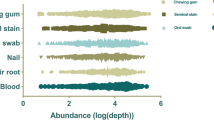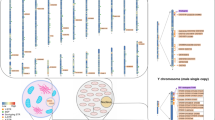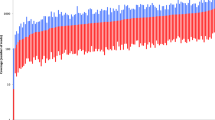Abstract
Genotype profiling has played a major role in forensics for decades. The technology for detection and discrimination has advanced substantially, from serology to DNA sequence analysis. Currently, there may be situations where there is a need for re-analysis of forensic DNA data that was produced using methodology that is no longer available. An example of this is the allele-specific oligonucleotide hybridization assays used in the 1990s. In the study presented herein, we have developed a multiplex system combining PCR and massively parallel sequencing (MPS) technologies to identify DNA polymorphisms. Our results are consistent with those found in the widely utilized AmpliType PM + DQA1 Amplification and Typing Kit originally marketed by Perkin Elmer. During the course of our studies, it became apparent that paralogous genes for two of the loci, GYPA and HBG2 (formerly HBGG), could have confounded the interpretation of the original assays, and we describe the technical solutions we developed to overcome ambiguity in genotype assignment. This study results in a novel resource enabling the re-analysis of DNA profiling results produced decades past using current day technology.




Similar content being viewed by others

Data availability
Data and materials will be made to other investigators upon request.
References
Gill P, Jeffreys AJ, Werrett DJ (1985) Forensic application of DNA ‘fingerprints.’ Nature 318:577–579
Saiki RK, Walsh PS, Levenson CH, Erlich HA (1989) Genetic analysis of amplified DNA with immobilized sequence-specific oligonucleotide probes. Proc Natl Acad Sci USA 86:6230–6234
Helmuth R, Fildes N, Blake E, Luce MC, Chimera J, Madej R, Gorodezky C, Stoneking M, Schmill N, Klitz W, Higuchi R, Erlich HA (1990) HLA-DQα A allele and genotype frequencies in various human populations, determined by using enzymatic amplification and oligonucleotide probes. Am J Hum Genet 47:515–523
Erlich HA, Bugawan TL (1992) HLA class II gene polymorphism: DNA typing, evolution, and relationship to disease susceptibility. In: Erlich HA PCR technology: principals and applications for DNA amplification. Palgrave Macmillan, UK, pp193–208
Yamamoto T, Davis CG, Brown MS, Schneider WJ, Casey ML, Goldstein JL, Russell DW (1984) The human LDL receptor: a cysteine-rich protein with multiple Alu sequences in its mRNA. Ceil 39:27–38
Siebert PD, Fukuda M (1987) Molecular cloning of human glycophorin B cDNA: nucleotide sequence and genomic relationship to glycophorin A. Proceedings of the National Academy of Sciences U.S.A., 84: 6735–6739
Slightom JL, Blechi AE, Smithies O (1980) Human fetal G gamma and A gamma-globin genes: complete nucleotide sequences suggest that DNA can be exchanged between these duplicated genes. Cell 21:627–638
Horn GT, Richards B, Merrill JJ, Klinger KW (1990) Characterization and rapid diagnostic analysis of DNA polymorphisms closely linked to the cystic fibrosis locus. Clin Chem 36:1614–1619
Yang E, Brune JL, Naylor SL, Apples RL, Naberhaus KH (1985) Human Group-Specific Component (Gc) Is a member of the albumin family. Proc Natl Acad Sci USA 82:7994–7998
Saiki RK, Nasarabadi SL (1992) Methods and reagents for gamma-globin typing. Patent 5273883
Fildes NJ, Reynolds RL (1994) Methods and reagents for Glycophorin A typing. Patent 5643724
Budowle B, Lindsey JA, DeCou JA, Koons BW, Giusti AM, Comey CT (1995) Validation and Population Studies of the Loci LDLR, GYPA, HBGG, D7S8, and Gc (PM loci), and HLA-DQα Using a multiplex amplification and typing procedure. J Forensic Sci 40:45–54
Herrin G Jr, Fildes N, Reynolds R (1994) Evaluation of the AmpliType | PM DNA test system on forensic case samples. J Forensic Sci 39:1247–1312
Edwards A, Civitello A, Hammond HA, Caskey CT (1991) DNA typing and genetic mapping with trimeric and tetrameric tandem repeats. Am J Hum Genet 49:746–756
Kimpton CP, Oldroyd NJ, Watson SK, Frazier RR, Johnson PE, Millican ES, Urquhart A, Sparkes BL, Gill P (1996) (1996) Validation of highly discriminating multiplex short tandem repeat amplification systems for individual identification. Electrophoresis 17:1283–1293
Baird ML (1998) Use of the AmpliType PM + HLA DQAI PCR amplification and typing kits for identity testing. Methods Mol Biol 98:261–278
Robinson JT, Thorvaldsdóttir H, Winckler W, Guttman M, Lander ES, Getz G, Mesirov JP (2011) Integrative genomics viewer. Nature Biotechnol 29:24–26
Sanger F, Coulson AR (1975) A rapid method for determining sequences in DNA by primed synthesis with DNA polymerase. J Mol Biol 25:441–448
Gettings KB, Lai R, Johnson JL, Peck MA, Hart JA, Gordish-Dressman H, Schanfield MS, Podini DS (2014) A 50-SNP assay for biogeographic ancestry and phenotype prediction in the U.S. population. Forensic Sci Int Genet 8:101–108
Higuchi R, von Beroldingen CH, Sensabaugh GF, Erlich HA (1988) DNA typing from single hairs. Nature (London) 332:543–546
Jeffreys AJ (1979) DNA sequence variants in the G gamma-, A gamma-, delta- and beta-globin genes of man. Cell 18:1–10
Tuan D, Biro PA, deRiel JK, Lazarus H, Forget BG (1979) Restriction endonuclease mapping of the human gamma globin gene loci. Nucleic Acids Res 6:2519–2544
Machiela MJ, Chanock SJ (2015) LDlink: a web-based application for exploring population-specific haplotype structure and linking correlated alleles of possible functional variants. Bioinformatics 31:3555–3557
The 1000 Genomes Project Consortium (2015) A global reference for human genetic variation. Nature 526:68–74
Author information
Authors and Affiliations
Corresponding author
Ethics declarations
Conflict of interest
Robert Lagacé is employed by Thermo Fisher Scientific, which markets instruments and supplies for biotechnology. His role on this project has been to advise and inform us on the use and interpretation of the DNA sequencing methods used.
Additional information
Publisher's note
Springer Nature remains neutral with regard to jurisdictional claims in published maps and institutional affiliations.
Supplementary Information
Below is the link to the electronic supplementary material.
Rights and permissions
About this article
Cite this article
Lewis, E.J., Weaver, E., Hoyle, A. et al. Retrofitting massively parallel sequencing (MPS) for HLA-DQA1 and polymarker (PM) in forensic casework. Int J Legal Med 136, 93–101 (2022). https://doi.org/10.1007/s00414-021-02647-3
Received:
Accepted:
Published:
Issue Date:
DOI: https://doi.org/10.1007/s00414-021-02647-3



